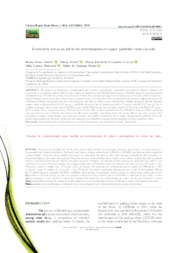Ecotoxicity test as an aid in the determination of copper guideline values in soils.
Ecotoxicity test as an aid in the determination of copper guideline values in soils.
Author(s): SIMÕES, B. F.; MAZUR, N.; CORREIA, M. E. F.; NIEMEYER, J. C.; MATOS, T. de S.
Summary: The process of identifying a contaminated area involves a preliminary assessment consisting of chemical analysis and comparison with guideline values. In Brazil, these values are included in the CONAMA Resolution no. 420/2009, based on chemical analysis and phytotoxicity. The objective of this research was to evaluate the ecotoxicity of copper in two natural soils in the state of Rio de Janeiro, a Haplic Planosol (sandy) and a Red-Yellow Argisol (medium texture), to verify if the values established by the legislation offer protection to the soil fauna. Lethality and reproduction tests were performed with Eisenia andrei worms and Folsomia candida springtails. Results indicated copper values in Planosol as LC50 435 mg kg 1 and EC50 29 mg kg 1 for E. Andrei and LC10 137 mg kg 1 and EC50 117 mg kg 1 for F. candida. In Argisol, these results were LC50 690 mg kg 1 and EC50 61 mg kg 1 for E. andrei, and LC10 42 mg kg 1 and EC50 138 mg kg 1 for F. candida. Values reported are lower than the research value (200 mg kg-1) established by the CONAMA resolution 420/09, indicating that concentrations lower than the limit values may affect these organisms, depending on the type of soil. Worms were more sensitive than springtails to copper contamination, and sandy soil was more susceptible to ecotoxicity due to copper contamination, probably due to the greater bioavailability of the metal. Results of such ecotoxicity tests should be considered in the development of soil guideline values. Key words: contaminated areas, risk assessment, terrestrial ecotoxicology, soil invertebrates, metals, natural soils.
Publication year: 2020
Types of publication: Journal article
Unit: Embrapa Agrobiology
Observation
Some of Embrapa's publications are published as ePub files. To read them, use or download one of the following free software options to your computer or mobile device. Android: Google Play Books; IOS: iBooks; Windows and Linux: Calibre.
Access other publications
Access the Agricultural Research Database (BDPA) to consult Embrapa's full library collection and records.
Visit Embrapa Bookstore to purchase books and other publications sold by Embrapa.

